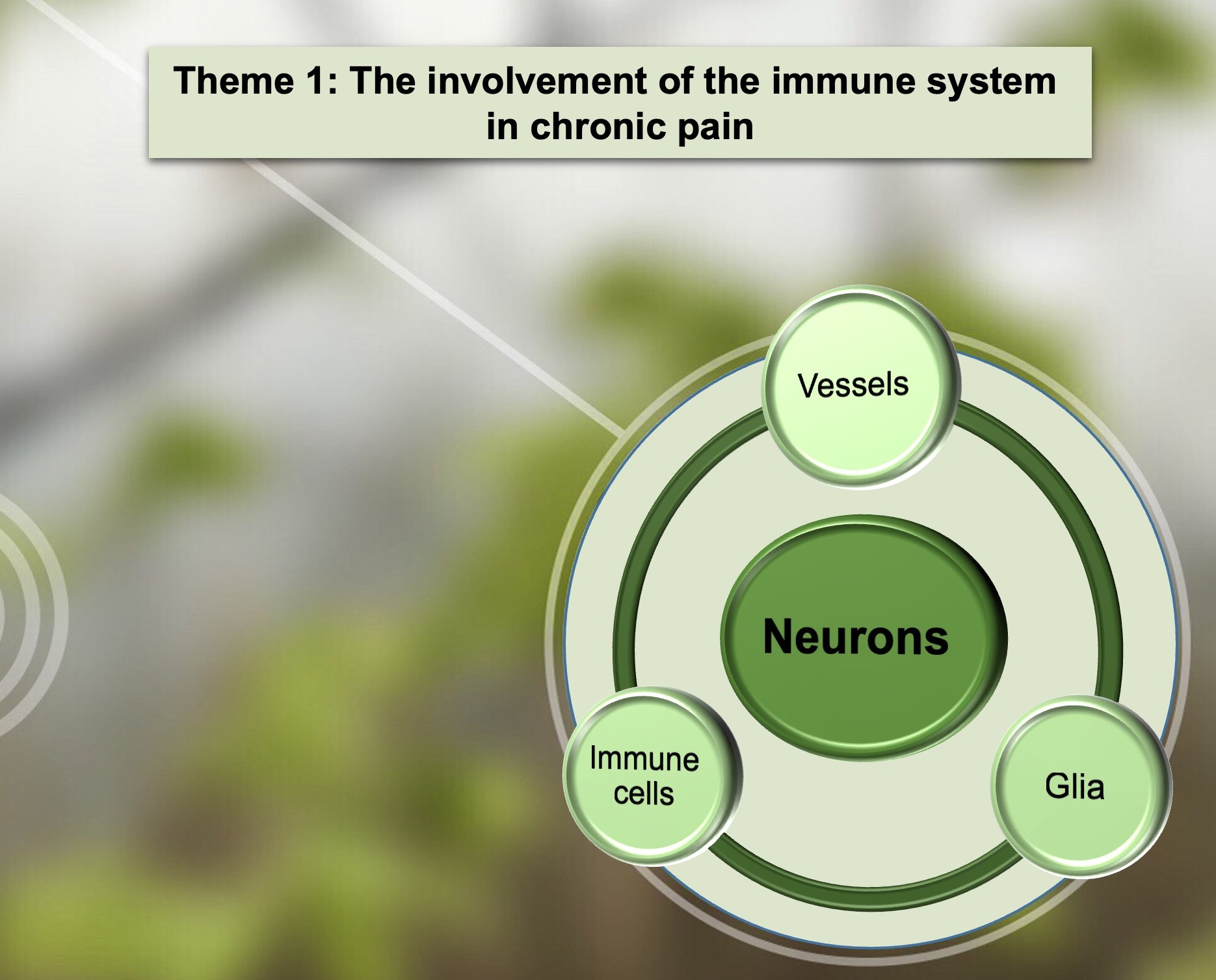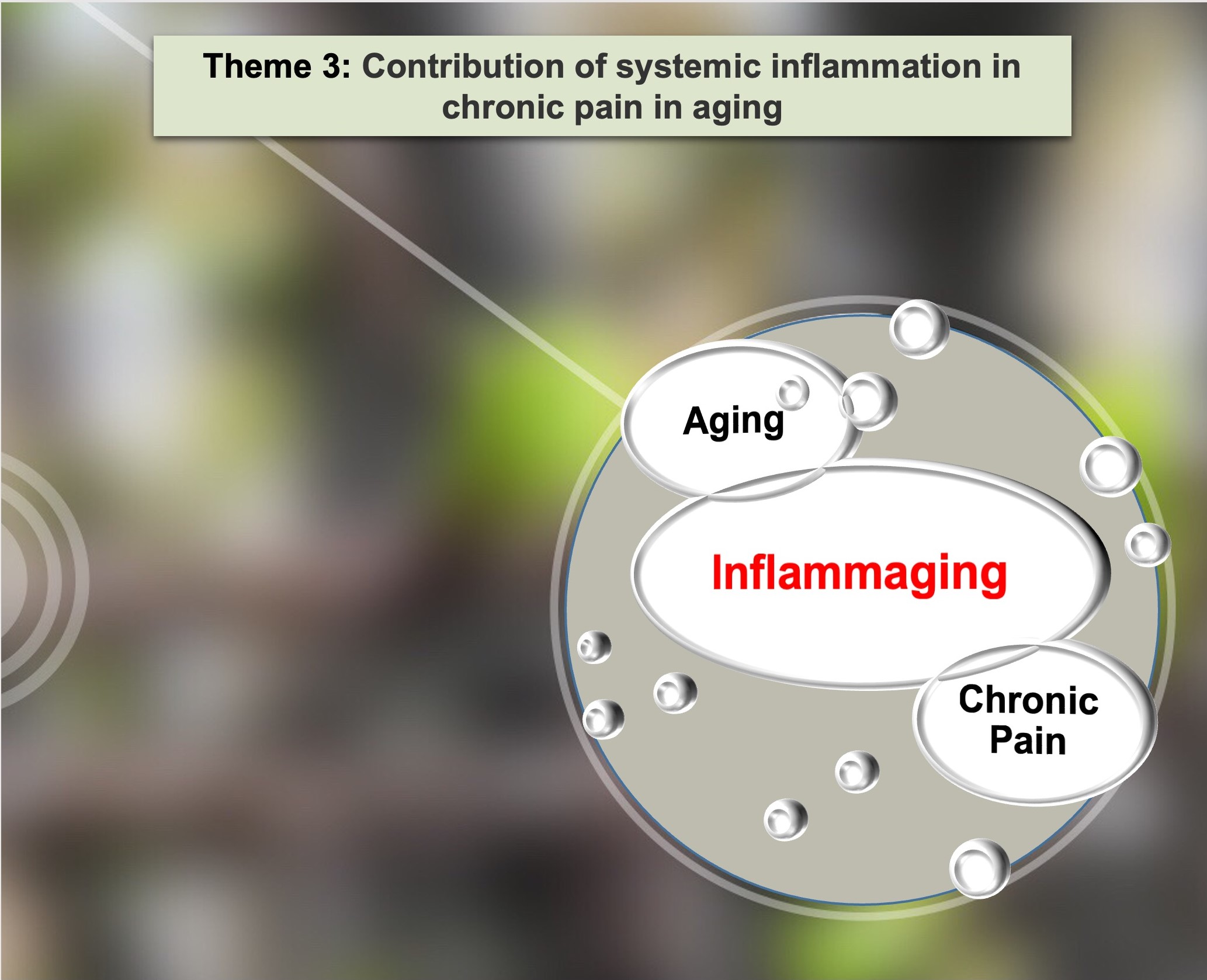Theme 1: The involvement of the immune system in chronic pain
Chronic pain is a sensory disorder resulting from infection, injury, cancer or some metabolic/neurodegenerative diseases, which has an enormous negative impact on the quality of life of individuals affected by this problem. While for decades, a neuron-centric view has predominated to explain the pathophysiology of chronic pain, studies from last two decades have uncovered extensive neuroimmune interactions as substrates. Crosstalk between the immune and nervous systems occurs at multiple levels, involving different types of non-neuronal cells and immune derived substances, contributing to chronic pain pathogenesis. The mainstream of our research program is to investigate the immune etiology of chronic pain by exploring the interaction between injured neurons and surrounding glial cells, immune cells and endothelial cells in the development and maintenance of abnormal pain behavior. We are also interested in understanding how systemic factors in the blood stream can influence PNS and CNS function, contributing to abnormal pain behavior.
Theme 2: Molecular and cellular mechanisms of autoimmune peripheral neuropathy
Autoimmune peripheral neuropathies, e.g., Guillain Barre Syndrome (GBS) and chronic inflammatory demyelinating polyradiculoneuropathy (CIDP), are debilitating diseases with both motor and sensory deficits. Chronic pain is one of the long-lasting complications. Although an environmental etiology, such as infection, injury and stress has been suspected, the underlying mechanisms remain elusive. By over expression of T cell co-stimulation factor B7.2, we have established an animal model where mice develop spontaneous autoimmune neurological disorders. We also discovered that under this genetic background, prior to spontaneous disease onset, any physical damage to one nerve could trigger autoimmune peripheral neuropathy to other non-damaged nerves. We use this unique tool to uncover molecular and cellular mechanisms leading to the initiation, progression and recovery of the disease. We are interested in the identification of decisive factor(s) connecting environmental triggers and the occurrence of GBS/CIDP. We expect that findings in theme could shed lights on new therapeutic strategy
Theme 3: Contribution of systemic inflammation in chronic pain in aging
Chronic pain increases with age. Unfortunately, it is often neglected, misdiagnosed, and not adequately treated. As consequences, it severely impacts seniors’ health, daily life independence and their quality of life. While the immune system changes with age, normal aging process is accompanied by a low-grade systemic inflammation, named as inflammaging, which has been considered as a driver for many age-related chronic diseases. However, its role in altered pain experience in the elderly is unknown. We aim to understand whether there is a correlation between the development of inflammaging and altered pain behavior in mice across lifespan; and whether inflammaging impacts directly age related-altered pain behavior. We also want to collect direct evidence from aging mice that counteracting inflammaging with healthy lifestyle could improve pain experience. We expect that through the proposed study, we will have a better understanding of chronic pain during the aging process. We will be able to provide guidance to seniors to improve their chronic pain experience and reduce associated discomfort by promoting healthy lifestyle. We want our parents and grandparents to have a better quality of Life.
Techniques and Approaches
Animal Models :
- Injury associated neuropathic pain (mouse, rat)
- Mouse model of temporomandibular joint disorder (TMD)

- Diabetic neuropathic pain (rat)
- Inflammatory pain (mouse, rat)
- Mouse model for autoimmune peripheral neuropathy
- Mouse model of specific diet induced abnormal pain behavior
Behavioral Testing:
- Von Frey test
- Acetone test
- Hot plate/Plantar test
- Rota Rod test
In Vivo Pharmacology:
- Drug administration via intraperitoneal, intravenous, intrathecal, subcutaneous, oral gavage routes
- Validation of drug targets in rodent animal models
Immunohistochemistry:
- Regular fluorescent microscopy
- Confocal microscopy
- Sophisticated image analysis software
Tissue-based cellular, molecular and biochemistry analysis:
- Flow cytometry
- Real time PCR
- Western Blot
- ELISA
- Luminex Assay
In vitro experiments:
- Primary cell culture
- Cell sorting


